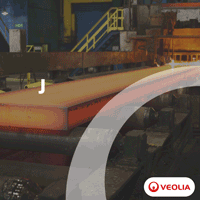Vallourec Awards Veolia Water Contract to Audit Its Water Footprint
09/20/2012 - To assess and compare the water footprint of seven of its biggest production plants worldwide, Vallourec has turned to Veolia Water’s new measurement and decision-making assistance tool: the Water Impact Index (WIIX).
To assess and compare the water footprint of seven of its biggest production plants worldwide, Vallourec has turned to Veolia Water’s new measurement and decision-making assistance tool: the Water Impact Index (WIIX).
Water is essential in the industrial production process of Vallourec, which is why the company — a world leader in premium tubular solutions for the oil and gas industry — pays constant attention to reducing the amounts used. In the space of 10 years, Vallourec has reduced its water withdrawals by 40% per tonne of tube produced.
Vallourec now intends to do more than simply measure how much water it extracts and wants to know the full impact of its water use on the natural environment.
Jean-Louis Merveille, Head of sustainability for Vallourec, commented, "We want to go beyond the usual approach based on knowing the amounts of water taken from the environment or from distribution networks, and instead learn what impact each of our industrial sites has on local water resources. We have the twofold objective of ranking our targets and action plans for water resource management, and of having on hand an educational tool to explain those targets and plans both internally and externally."
For those reasons, Vallourec selected Veolia Water to help it asses the water footprint of its seven biggest sites by using the Water Impact Index (WIIX): Saint-Saulve (tube and steel mill) and Déville-les-Rouen in France, Mülheim and Rath in Germany, Youngstown in the United States and Belo Horizonte in Brazil. In addition to the amounts of water they extract, the sites were chosen on the basis of their water management costs and their representativeness of Vallourec’s main geographical production regions.
Developed by the Veolia Environnement research and innovation center (VERI), the WIIX does not simply quantify the volumes of water used. It takes into account three crucial elements: the quantity of water used, the level of stress on water resources, and the overall quality of the water.
The WIIX, which assesses the effects of human activity on water resources, also establishes a methodology that defines the positive and negative effects of choices in regard to water resource management. It gives decision-makers the elements they need to make informed choices about water use technologies and operating strategies.
This multi-criteria approach has revealed and quantified the exact challenges for Vallourec in relation to water stress and the quality of the resource in certain regions.
Comparing several production facilities and operating scenarios enabled the company to set goals and demonstrate the relevance of the actions already taken or to come at its plants.
Philippe Sébérac, Director of Industrial Activities at Veolia Water’s Technical Division, said, "By calling on Veolia Water to apply the new Water Impact Index to its facilities, Vallourec has put in place an innovative approach to measuring its environmental impact, in particular by comparing the water performance of several of its plants. The WIIX is a pragmatic, structured and analytical approach that all responsible players can make use of."
The Water Impact Index can also be used to measure the impact of a business on a water resource, including indirect elements of the production chains such as energy, raw materials, chemicals, and waste generated.
Jean-Louis Merveille, Head of sustainability for Vallourec, commented, "More detailed knowledge of the water footprint of each of our plants will enable us to better target our improvement plans and raise awareness of the issues relating to water resource management."
Other installations that are among Vallourec’s highest water consumers should soon also be put to the test by the WIIX.
Jean-Michel Herrewyn, Chief Executive Officer of Veolia Water, said, "Our role and our responsibility is to constantly invent and innovate so that we can offer our clients the best possible support in anticipating risks and reducing their environmental impact. We want to be the benchmark for industrial companies in decision-making assistance tools for all aspects of sustainability."



-(220-x-200-px)-(130-x-130-px)-(220-x-200-px).jpg?lang=en-US&ext=.jpg)
.gif?width=200&height=200&mediaprotectionhash=ddb07947ad3b4ab959a83714461eccd5c6895f370695eb035a9ff7aa736f8ad9&ext=.gif)





